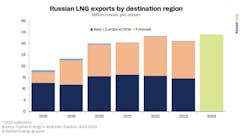Marilyn Radler
OGJ Senior Editor-Economics
HOUSTON, May 11 -- In its latest short-term energy outlook (STEO), the US Energy Information Administration projects that US real gross domestic product will grow by 3% this year, while worldwide real oil-consumption-weighted GDP will increase by 3.6%. Both of these projections are 0.2% higher than in EIA’s previous outlook.
For 2011, EIA forecasts real GDP growth will be 2.9% in the US and 3.7% worldwide.
The more optimistic economic growth forecasts lead to an increase of about $2/bbl in EIA's projections for West Texas Intermediate crude spot prices compared with the month-earlier outlook. EIA expects WTI prices to average $84/bbl during the second half, rising to $87/bbl by the end of next year.
EIA forecasts that regular-grade motor gasoline retail prices will average $2.94/gal during this summer's driving season (Apr. 1 through Sept. 30), up from $2.44/gal last summer. The summer gasoline price forecast is up 2¢/gal from last month’s STEO.
The latest report calls for the Henry Hub natural gas spot price to average $4.48/MMbtu this year. This is up 4¢/MMBtu from last month's forecast and up 53¢/MMbtu over the 2009 average. EIA expects the Henry Hub spot price to average $5.34/MMbtu in 2011.
Oil demand, supply
Also as a result of greater expected economic growth, EIA has raised slightly its forecast for oil demand from a month ago. EIA now forecasts that global oil consumption will increase by 1.6 million b/d this year and by 1.6 million b/d in 2011. The rise in oil consumption will be largely concentrated in Asia-Pacific and the Middle East.
In the US, EIA calls for oil consumption to rise by 160,000 b/d, or 0.8%, in 2010. All of the major petroleum products are expected to register growth except for distillate fuel oil and jet fuel, which will be nearly unchanged from last year.
The new STEO calls for 2011 US oil consumption to increase by 260,000 b/d, or 1.4%, with all of the major product categories registering growth. Despite increases in 2010 and 2011, projected liquid fuels consumption in 2011 is lower than annual consumption from 1999 through 2008, EIA said.
US oil output this year will increase by 190,000 b/d, compared to growth of 370,000 b/d in 2009. The primary contributors to the production growth in 2009 and 2010 are Thunder Horse, Tahiti, Shenzi, and Atlantis offshore fields, all in the Gulf of Mexico.
Total US crude production in 2011 will drop by 16,000 b/d, with declines in the gulf and Alaska more than offsetting growth in Lower-48 output, according to the STEO.
Natural gas
EIA expects US gas consumption to increase by 3% this year to 64.4 bcfd, led by industrial and electric power users. Despite higher prices in the first quarter compared with the year-earlier period, gas accounted for a slightly higher share of generation in electric power, and this gain is expected to continue throughout this year.
US gas demand will decline by 0.4% in 2011. EIA’s forecast of higher gas prices restrains gas use in the electric power sector next year. In addition, the assumption of a 2.2% decline in first-quarter heating degree days next year and the resulting decline in space heating demand reduces residential and commercial sector consumption. However, EIA expects that continued growth in industrial output will lead to a 1.3% increase in industrial gas consumption in 2011.
EIA expects US marketed gas production to increase by 1.3% to 60.7 bcfd this year and to decline by 0.5% in 2011.
“Although the working natural gas rig count has declined in recent weeks, the resurgent trend in drilling activity from last year's low contributes to the outlook for production growth in 2010. With a forecast of lower prices throughout the remainder of 2010 relative to the first quarter, EIA expects some continuation of the recent reduction in drilling activity. The lagged effect of sustained lower drilling in the forecast contributes to a slight decline in production during 2011,” the STEO said.
Contact Marilyn Radler at [email protected].

